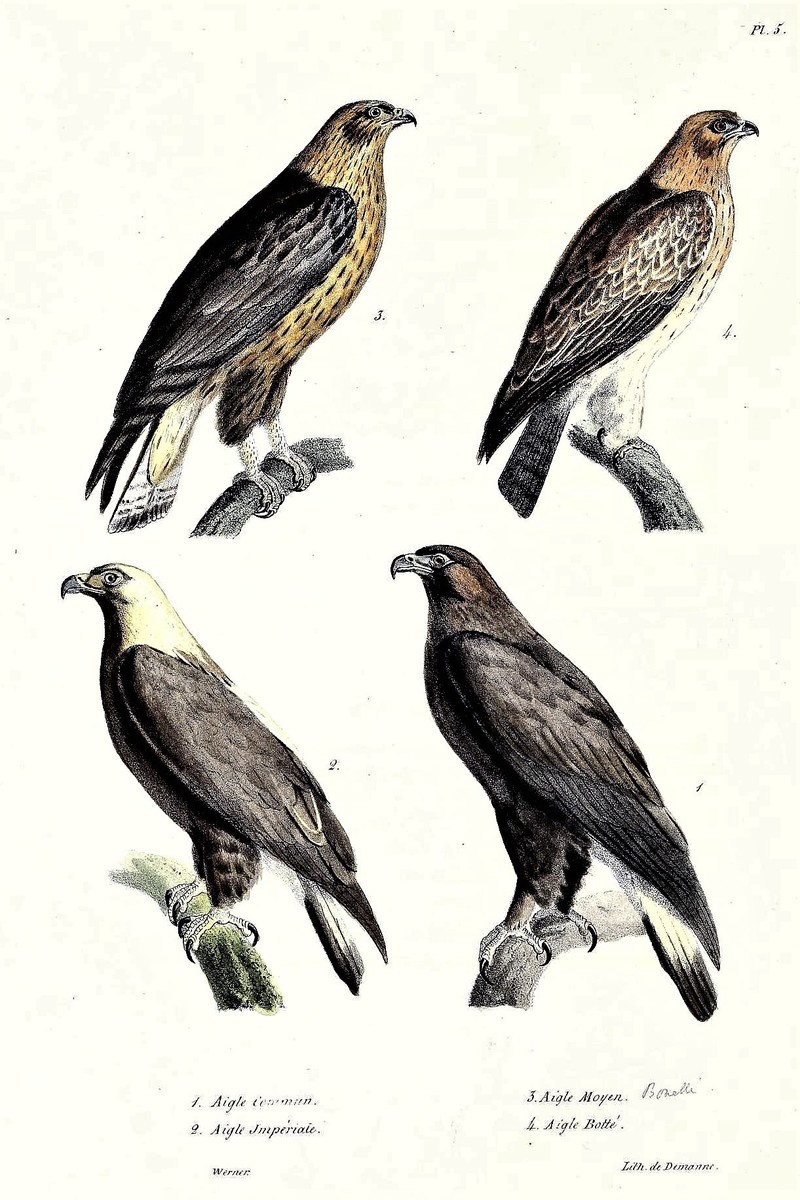|
| 질의: Birds of europe | 결과: 143번째/1706 | |
Bonelli's eagle (Aquila fasciata), Booted eagle (Hieraaetus pennatus), Eastern imperial eagle (Aquila heliaca), Golden eagle (Aquila chrysaetos)
| 제목: | Bonelli's eagle (Aquila fasciata), Booted eagle (Hieraaetus pennatus), Eastern imperial eagle (Aquila heliaca), Golden eagle (Aquila chrysaetos)
| | 올린이: | Wiki Photos (---@---.---)
| |

| 해상도: 1221x1832
파일크기: 535457 Bytes
촬영일: 2022:12:16 21:26:50
등록시간: 2023:02:23 13:52:46
|
(3) Aigle Moyen (4) Aigle Botté
(2) Aigle Impériale (1) Aigle Commun
(3) Aigle Moyen = Bonelli's eagle (Aquila fasciata)
(4) Aigle Botté = booted eagle (Hieraaetus pennatus)
(2) Aigle Impériale = eastern imperial eagle (Aquila heliaca)
(1) Aigle Commun = golden eagle (Aquila chrysaetos)
Date 1824
Source https://www.biodiversitylibrary.org/item/230685#page/44/mode/1up Histoire naturelle des oiseaux de proie d'Europe by Pierre Boitard, 1789-1859
Author Jacques Christophe Werner (1798-1856)
Source: https://upload.wikimedia.org/wikipedia/commons/1/1f/Aquila_chrysaetos_Aquila_heliaca_Aquila_fasciata_Hieraaetus_pennatus.jpg
(3) Aigle Moyen = Bonelli's eagle (Aquila fasciata)
The Bonelli's eagle (Aquila fasciata) is a large bird of prey. Some antiquated texts also refer to this species as the crestless hawk-eagle. Like all eagles, Bonelli's eagle belongs to the family Accipitridae. Its feathered legs marked it as member of the Aquilinae or booted eagle subfamily. Order: Accipitriformes > Family: Accipitridae > Genus: Aquila > Species: Aquila fasciata
(4) Aigle Botté = booted eagle (Hieraaetus pennatus)
The booted eagle (Hieraaetus pennatus, also classified as Aquila pennata) is a medium-sized mostly migratory bird of prey with a wide distribution in the Palearctic and southern Asia, wintering in the tropics of Africa and Asia, with a small, disjunct breeding population in south-western Africa. Like all eagles, it belongs to the family Accipitridae. Order: Accipitriformes > Family: Accipitridae > Genus: Hieraaetus > Species: Hieraaetus pennatus
(2) Aigle Impériale = eastern imperial eagle (Aquila heliaca)
The eastern imperial eagle (Aquila heliaca) is a large bird of prey that breeds in southeastern Europe and extensively through West and Central Asia. Most populations are migratory and winter in northeastern Africa, the Middle East and South and East Asia. Like all eagles, the eastern imperial eagle is a member of the family Accipitridae. Furthermore, its well feathered legs mark it as a member of the subfamily Aquilinae. Order: Accipitriformes > Family: Accipitridae > Genus: Aquila > Species: Aquila heliaca
(1) Aigle Commun = golden eagle (Aquila chrysaetos)
The golden eagle (Aquila chrysaetos) is a bird of prey living in the Northern Hemisphere. It is the most widely distributed species of eagle. Like all eagles, it belongs to the family Accipitridae. They are one of the best-known birds of prey in the Northern Hemisphere. These birds are dark brown, with lighter golden-brown plumage on their napes. Order: Accipitriformes > Family: Accipitridae > Genus: Aquila > Species: Aquila chrysaetos |
^o^
동물그림창고 똑똑전화 누리집
^o^
|
|